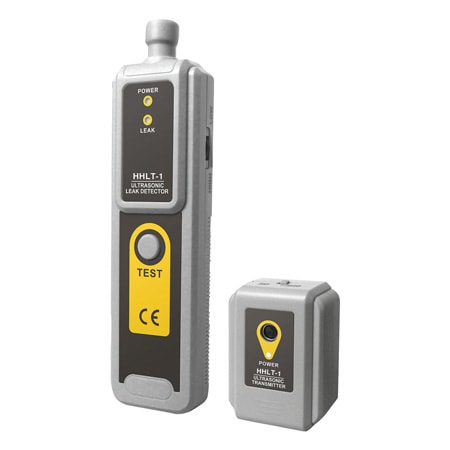1-800-663-4209 | Bienvenue sur notre nouveau site Web, vous avez rencontré un problème ou un bug? Veuillez le signaler ici

HHLT-1-Leak-Detector
Ultrasonic Air or Gas Leak Detector
- 20 kHz to 100 kHz
- For Air or Gas Leaks
- Economical
- Applications
HHLT-1-Leak-Detector
Depuis
C$
189.00
L'aperçu du produit
- Alarm Indication 40 kHz
- Battery Size and Type Alkaline 9V
- Dimensions Note Transmitter Dimensions -120 L x 60 W x 38 D mm_x000D_ Receiver Dimensions - 150 L x 90 W x 50 D mm
- Display and Indications Earphone, Led
- Height 50 mm
- Indicator Type LED
- Length 150 mm
- Operating Humidity 0 to 80% RH
- Operating Temperature, Max 40 °C
- Operating Temperature, Min 0 °C
- Operating Temperature Note 0 to 40°C For Both Receiver and Transmitter
- RF Frequency 36 to 44 kHz
- Sensor Height 38 mm
- Sensor Length 120 mm
- Sensor Width 60 mm
- Storage Temperature, Max 40 °C
- Storage Temperature, Min -10 °C
- Storage Temperature Note -10 to 40°C For Both Receiver and Transmitter
- Weight 125.5 g
- Weight Note Transmitter Weight : 93.5 g_x000D_ Receiver Weight : 125.5 g
- Width 90 mm
Ultrasonic sound (20 to 100 kHz) is generated by turbulence created by air or a gas forced through a small orifice. Ultrasonic sound is very directional in nature and can be used to pinpoint the exact location of the leak point. Leaking air or gas is generally considered to be viscous flow and as the flow velocity increases, the frequency of the ultrasonic sound emitted will become higher. The HHLT-1R amplifies and converts these sounds to frequencies and levels that the human ear can hear. The HHLT-1T transmitter can supply ultrasonic signals for locations where the gas/air leak does not have sufficient pressure to create an ultrasonic sound. This transmitter will allow the ultrasonic detection of cracks and openings.
Detection Principle
When a gas passes through a restricted orifice under pressure, it's going from a pressurized laminar flow to low pressure turbulent flow. The turbulence generates a broad spectrum of sound called "white noise". There are ultrasonic components in this white noise. Since the ultrasound will be loudest by the leak site, the detection of these signals is usually quite simple.
Detection Principle
When a gas passes through a restricted orifice under pressure, it's going from a pressurized laminar flow to low pressure turbulent flow. The turbulence generates a broad spectrum of sound called "white noise". There are ultrasonic components in this white noise. Since the ultrasound will be loudest by the leak site, the detection of these signals is usually quite simple.